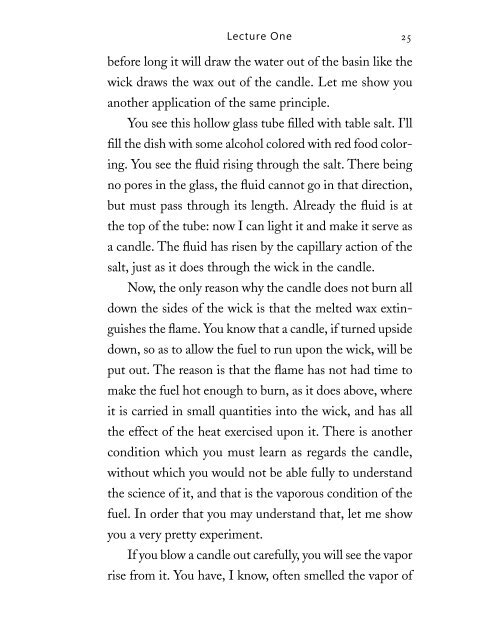Michael Faraday's The Chemical History of a Candle
Michael Faraday's The Chemical History of a Candle With Guides to Lectures, Teaching Guides & Student Activities by Bill Hammack & Dos DeCoste
Michael Faraday's The Chemical History of a Candle With Guides to Lectures, Teaching Guides & Student Activities by Bill Hammack & Dos DeCoste
Create successful ePaper yourself
Turn your PDF publications into a flip-book with our unique Google optimized e-Paper software.
Lecture One<br />
25<br />
before long it will draw the water out <strong>of</strong> the basin like the<br />
wick draws the wax out <strong>of</strong> the candle. Let me show you<br />
another application <strong>of</strong> the same principle.<br />
You see this hollow glass tube filled with table salt. I’ll<br />
fill the dish with some alcohol colored with red food coloring.<br />
You see the fluid rising through the salt. <strong>The</strong>re being<br />
no pores in the glass, the fluid cannot go in that direction,<br />
but must pass through its length. Already the fluid is at<br />
the top <strong>of</strong> the tube: now I can light it and make it serve as<br />
a candle. <strong>The</strong> fluid has risen by the capillary action <strong>of</strong> the<br />
salt, just as it does through the wick in the candle.<br />
Now, the only reason why the candle does not burn all<br />
down the sides <strong>of</strong> the wick is that the melted wax extinguishes<br />
the flame. You know that a candle, if turned upside<br />
down, so as to allow the fuel to run upon the wick, will be<br />
put out. <strong>The</strong> reason is that the flame has not had time to<br />
make the fuel hot enough to burn, as it does above, where<br />
it is carried in small quantities into the wick, and has all<br />
the effect <strong>of</strong> the heat exercised upon it. <strong>The</strong>re is another<br />
condition which you must learn as regards the candle,<br />
without which you would not be able fully to understand<br />
the science <strong>of</strong> it, and that is the vaporous condition <strong>of</strong> the<br />
fuel. In order that you may understand that, let me show<br />
you a very pretty experiment.<br />
If you blow a candle out carefully, you will see the vapor<br />
rise from it. You have, I know, <strong>of</strong>ten smelled the vapor <strong>of</strong>


